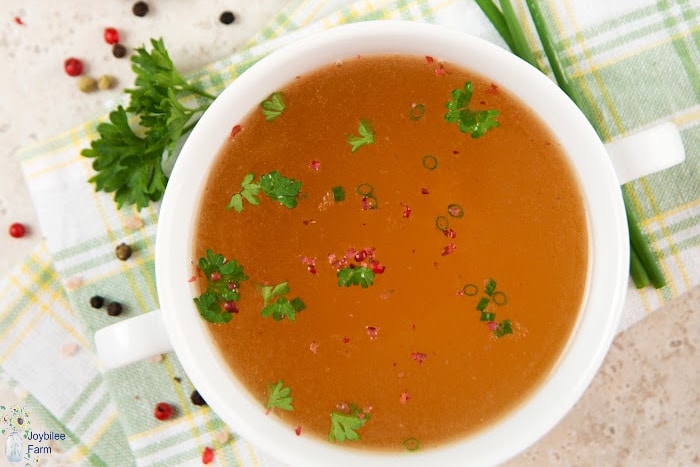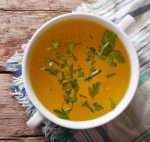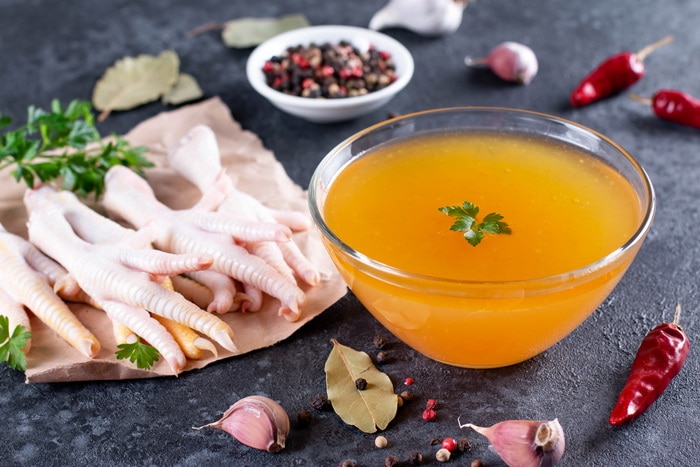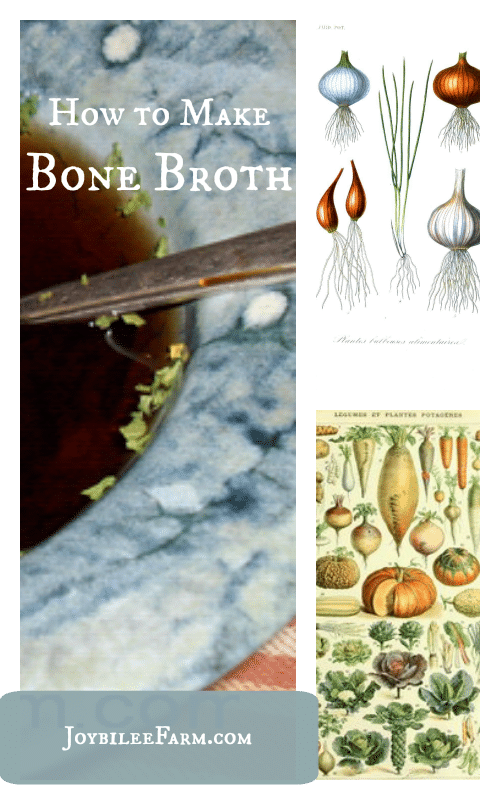Bone broth is an easy and effective way to increase nutritional value of soups and stews, as well as making your own delicious bullion replacement. Homemade broth can be stored in the freezer, if you make it in bulk, and has great flavor even after being frozen.
Bone broth restaurants are popping up in cities across North America. And for good reason. Bone broth is full of protein, minerals, and vitamins essential to good health. It heals gut issues as well as remineralizing bones and teeth. It is rich in collagen which can help improve the strength of your nails, too. Properly made, bone broth is rich in collagen, gelatin, as well as calcium, magnesium, and phosphorous. These are the compounds that hold your body together and help it rebuild. It’s also super easy to digest, and helpful for improving gut health.
How to make bone broth
Bone broth is a miracle food when made from grass-fed, organically raised animals. If you have been wondering how to make bone broth at home, know that making bone broth couldn’t be easier.
I have a pot of bone broth brewing on my kitchen counter daily. It’s ready for quick lunches, healthy snacks, or hearty dinners. While some people pressure can or freeze theirs to store it for convenience, I don’t. I just keep a perpetual pot of bone broth brewing in my crockpot. It helps that we raise our own pastured lambs and have an endless supply of soup bones.
Where to get the bones?
If you are having trouble finding bones to make bone broth, speak to your local farmer of grass-fed livestock, butcher, or meat cutter. A lot of bones end up being discarded because boneless meat is easier to market. The whole animal is no longer being sold in the grocery store. But it’s available. You just have to ask. Many stores will have bones available in the freezer section, they may be labelled as soup bones, or as marrow bones.
You can also use a bone-in roast, or a chicken with bones, for your bone broth base. Technically, you can also use fish bones, and they make a nice fish stock with many of the same nutritional benefits of bone broth. Simply, use all the bones you can from the meat types you consume.
I do prefer using bones from grass fed or organic meats.
You can also use unusual cuts like chicken feet for amazingly healthy chicken soup stock. Short ribs, knuckle bones, and other heavy bone-in cuts also work in this bone broth recipe. The key thing is lots of bones.

Make Your Bone Broth
You’ll need a crockpot, some meaty bones, rich in cartilage, from organic or grass-fed animals, like lamb shanks, oxtails, chicken backs and necks, or a turkey carcass. Don’t use nonorganic animals. Many of the chemicals that conventionally raised animals are exposed to will be found in their bones, cartilage, and joints. You want to avoid that. So buy organic or grass-fed bones for long cooked broth.
Start your bone broth after dinner and let it simmer on warm all night in the crockpot. The long simmer is the secret to making the best, most nutritious bone broth. Cooking time is variable, which is why I prefer the slow cooker.
Put the bones in the crockpot. It’s fine if there is still some meat on the bones. Most of the flavour will end up in your broth. Cover with filtered water. Add finely chopped onions, garlic, and celery. Plugin the slow cooker and let it simmer on low overnight. In the morning add 1 tbsp. apple cider vinegar and ½ tsp. of sea salt. Continue simmering the bones on low.
By mid-morning, the following day, any meat on the bones will be tender and separate from the bones. You can remove this meat from the bones and chop it finely and return it to the pot, with the bones. Let it simmer a little longer, with the bones. If it starts to boil rapidly reduce the temperature to warm. It doesn’t need to boil.
Make it as a stock style bone broth by using clean onion skins, celery bases and leaves, carrot tops, and other clean vegetable peelings. Avoid using the choice parts of your vegetables when making stock, then you can just strain the broth, saving the liquid, and discard the solids into the compost or green bin.
Print
How to Make Bone Broth the Easy Way
Description
A basic, slow cooker or crock pot bone broth recipe.
Ingredients
- 1 pound of bones
- 1 onion
- 3 stalks celery
- 3 cloves garlic
- 1 tablespoon apple cider vinegar
- 1/2 teaspoon sea salt
Instructions
- Start your bone broth after dinner and let it simmer on warm all night in the crockpot. The long simmer is the secret to making the best, most nutritious bone broth.
- Put the bones in the crockpot. It’s fine if there is still some meat on the bones. Most of the flavour will end up in your broth. Cover with filtered water. Add finely chopped onions, garlic, and celery. Plugin the crockpot and let it simmer on low overnight. In the morning add 1 tablespoon apple cider vinegar and ½ tsp. of sea salt (these can also be added when first setting up the broth). Continue simmering the bones on low.
- By mid-morning, the following day, any meat on the bones will be tender and separate from the bones. You can remove this meat from the bones and chop it finely and return it to the pot, with the bones. Let it simmer a little longer, with the bones. If it starts to boil rapidly reduce the temperature to warm. It doesn’t need to boil.
When is it ready?
You can remove the clear broth at any time, after the first 8 hours to drink. Just add more water to replace what you used. You can add spices to taste in your individual servings, or use the broth as a base for another dish. Chicken bones will soften so that most become crumbly, as the minerals leach out of them. Beef bones or lamb bones will lighten in colour, as the minerals leach out. Once the bones seem spent, about 36 to 48 hours after you begin, you can remove them from the pot. Add the spent bones to your compost pile for added plant nutrition.
Use a fine mesh strainer to help remove the bones and veggie scraps from your broth, and keep a nice clean broth that is ready to use, freeze, or even can.
Avoid using whole chicken or a whole bone-in roast as the base for your broth. Broth is best made from stripped bones for the accessibility of the bone’s nutrients. Add meat back in when assembling a fresh soup or stew. This also keeps the meat tender, and prevents it drying out or becoming chewy from over-boiling.
When assembling a soup from your home made broth or stock, add your fresh herbs, rice, quinoa, and veggies at that time. Avoid over-cooking fresh herbs in the bone broth itself.

How to remove the top oil layer from your bone broth
If you desire to reduce the fat in your broth, you can siphon off the top layer of melted grease by using a gravy ladle. Just put the ladle into the crockpot, so that the handle is upright, and the rim of the ladle is just barely below the surface of the broth. Any grease layer on top of the liquid will fill the ladle. You can repeat this several times to remove the fat from your broth. Save the grease for your dogs and cats, if you don’t want to eat it yourself. The extra nutritious fat will make their coats shine and their skin condition improve.
How to use the finished bone broth?
Your homemade broth can be drunk in a mug like tea.
Bone broth can be used as the base for vegetable soup. Just add some dulse or other seaweed, carrots, beets, parsnips, potatoes, parsley, and any other seasonal vegetables that you have on hand. Simmer for about an hour on low in the crockpot. Eat it when the vegetables reach your desired doneness.
Bone broth can be used as the flavour base for gravies and sauces. Use it in any recipe that calls for consommé. Use it as a substitute for water or milk in savoury white sauce or béchamel sauce.
Make more bone broth
Our crockpot full of bone broth lasts about 2 days and then I feed that last of it to our cats and dogs, wash the crockpot, and get another batch started. It’s so easy to make that I keep a pot going regularly. It makes fast, easy, nutritious lunches, and hearty soup or stew for dinner on nights that we need fast food. I can vary the flavour by adding different vegetables or spices.
Roasted bones can still be used for bone broth, and some people say oven roasted bones add more flavor to the broth. Experiment with different ingredients, stove top or instant pot cooking methods, and see what works best for you.
A word about seaweeds
I add dulse, kelp, or seaweed to all my broths, soups, and stews. The extra trace minerals and iodine in the seaweed support thyroid and adrenal health. Just a ¼ cup per gallon of broth is enough to make a big difference in your well-being.
Spices:
Bay leaf and other tough spices are great to add to the homemade broth when initially simmering it, this helps extract maximum flavor and you don’t have to worry about missing a leaf or piece of reishi mushroom if you’re straining out everything.
Mushrooms provide a great umami flavor to broths and stocks, especially tough flavorful ones like reishi and shiitake. Include these in your chicken broth or beef broth for a more pho-like flavor.
Preserving your Bone Broth:
Bone broth, whether beef bone broth or chicken bone broth, will keep in the fridge for 3-5 days. I like storing my bone broth in mason jars in the fridge, if I’m not immediately turning it into a soup.
You can also freeze the bone broth in ice-cube trays. Simply pour cool broth into your ice cube trays and freeze. Pop them out and store in a freezer bag for up to 6 months.
Lastly, you can can the broth and soups made with homemade broth in your pressure canner.




Where do you buy dulse? I am not familiar with it at all. Should it be raw? Organic?
Good morning I was not sure I would keep your site. When you email arrived this morning I had my doubts.
When I went to your site this morning. I was very impressed and will continue to welcome your emails.
Keep up the great work. I am a Master compounding Herbalist and a small holding farmer in Canada near Toronto Ontario.. This has just been a hobby until now. With the way things are going in the world getting back to an easier laid back way of life seems the way to go. We have had up to 30 head of scotish highland cattle. Since retiring we are getting back into everything natural.
I have started to work with natural fibers . I am starting with raw wool. and I am learning to hand spin. I have also started my own raw dog food company.
Have a GREAT DAY
Colleen in Canada
a
I make soup from pork neck bones I buy at the store. It is delicious. I’ve never cooked bones for 36-48 hrs though. It seems like a really long time. Will try it with beef bones ASAP.
Not fishy at all, Tessa, but it does have that fresh sea smell — kind of like salty wind. It’s more salty than fishy. And I like using dulse as flakes. I find the powdered kelp hard to integrate into the broth but the dulse just puffs out like parsley or thyme and you hardly notice it.
Thank you for mentioning the seaweed – I hadn’t ever thought of that! How fishy does it end up tasting – I live with five small children who eat fish all the time but, for whatever reason, won’t take their flavored cod oil without acting like they’re going to die. I’ve tried them on basic sushi and same response. They will eat curry, though, so I figure life is give and take.